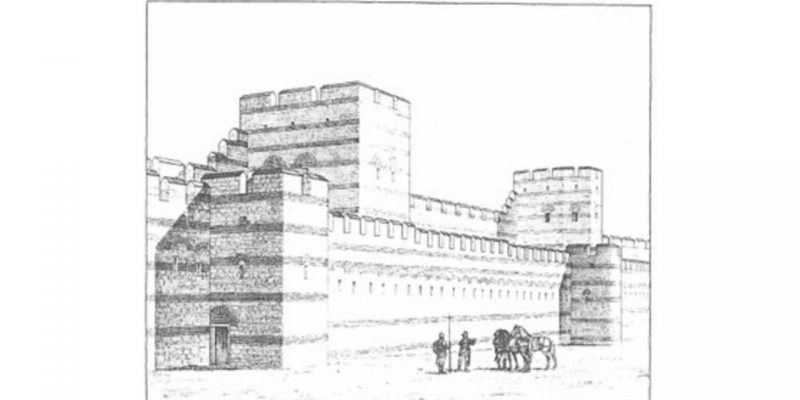A mother takes her son to the outskirts of the land to edge of the sea. She shows him a great city. A city filled with exquisite beauty and magnificence and historical importance. Then she would tell the young boy that he would one day conquer the city, for the sake of God.
This great city was the city of Constantinople, and the young boy would grow to be its conqueror. The young boy’s name would one day be known, far and wide, as Muhammad Al Fatih.
The city of Constantinople was first known the city of Lygos. It was established between the 11th and the 13th Century by the Thracians and aptly abandoned by the time the Greeks settlers made their way to these plains. The city of Lygos was then razed to the ground by the emperor Septimius Severus before the refoundation of the city be the emperor Constantine I. Imprinting his name in the annals of history renaming the city ‘Kōnstantinoupolis’, or ‘City of Constantine’. In 330 the emperor declared the city the New Rome and made the city the capital of the Roman Empire. This distinction would last as it remained the last bastion and Imperial capital as the western part of the Roman Empire eventually succumbed to barbarians.
By the 1450s, the Roman Empire had lost much of its prestige and lands and their Empire stretched only a few square kilometers from Constantinople itself. The city had held out through various sieges and truly remained the last bastion of Imperial power. The last stronghold, the city was then known as the mother of all cities noted for its beauty and prestige coupled with its refusal to be captured except for a brief period by the Crusaders. It was then the City, gave a false sigh of relief as the young Mehmed, then at the mere age of 19 succeeded his father for the Imperial Ottoman throne.
Mehmed would soon prove the sense of relief by making avid preparations for war by building a fortress on the European side of the Bosporus. This fortress was called the Throat Cutter, after its strategic position to block armies from the sea coming to the aid of the Byzantines. This was a bold declaration of the war, and the Byzantines soon reacted by pleading for help from its western allies. However, no help came except for a few individuals and accomplished soldiers such as the famed Giovanni Giustiniani from Genoa. And thus, the stage was set for war.
Sultan Mehmed built a Grand Ottoman navy which contemporary estimates of 110 to 430 ships. He employed a Hungarian canon maker and in conjunction with the Turkish engineers was able to amass around 50 to 200 cannons. It is estimated that the young Sultans army consisted of around 50 to 70 thousand soldiers. In response, the Byzantines deployed a great chain blocking of the naval route for the Ottoman ships to attack and holed up inside preparing to deter the attack. For the Byzantines, it was their last stronghold, and it was a duty upon them to protect the grand Roman legacy and Empire. To fall now would be the end, and they were prepared for war.
The siege began with the roar of canons soon followed by orders of direct frontal assaults order by Mehmed. Cannon fire roared for weeks against wall soon to be followed by soldiers trying to climb. The Sultans ships remained blocked by the chain from entry to the Golden Horn (a waterway near Istanbul) much to the dismay of Mehmed even allowed some Byzantine allies to pass though. The young Sultan in response showed his ingenuity by greasing logs and creating a path for the ships to bypass the chain by the land.
Days were spent which eventually turned into weeks on the frontal assaults. But the Byzantines repaired the wall at night by taking the fallen of pieces and reassembling them making the wall even stronger than before. The Ottoman soldiers fared no better and heavy casualties was imposed upon the Ottomans. It was truly a place of grand war and the young Sultan felt a cold sweat on his cheeks. None to be outdone, the Sultan ordered construction of tunnels to find their way beneath the wall to the other side.
However, these efforts were for naught as Byzantines lit it with Greek fire and annihilated the tunnels with it and heavy combat. Much to the Sultans dismay, the position of these tunnels was found out by 2 captured Turkish soldiers who broke under torture. Furious, the young sultan called for council. Some viziers had begun to doubt the young Sultan, including Halil Pasha who had being against the siege from the beginning. They urged the young Mehmed to let this ambition go. But the Sultan still entrusted some of his supporting viziers and allies held on. This was the closest anyone has come to taking over Constantinople and the Sultan intended rain blood against its walls to realize his dream, as well as his ancestor’s.
Mehmed rallied his troops and mobilized them for an all-out frontal assault and this the signal for the final assault began. Ottoman blood splashed against the walls as the swords cut through the attackers. But the Sultans troops refused to surrender. Shouting the name of Allah, the attackers gave of themselves as they have never done and finally breached the walls of the great city. Mehmed watched as his men created this victory and perhaps his heart flickered a little. The dream of his mother is finally being achieved. Drenched in blood the victorious army entered the city. Drenched in conquest, an emperor whose name would forever be etched in history soon entered the city.
‘Muhammad Al Fatih’, or Muhammad the Conqueror had finally taken and walked into his imperial capital. The capital of a majestic Empire and the capital of the Islamic world for the centuries. A city which would come to be known as Istanbul.
The story of Muhammad Al Fatih is remembered greatly remembered as one of the grand stories of conquests. While that is true and the Sultan received title of ‘Kaiser-of-Rum’ for his effort and his soldiers 3 days of plunder. It is important to understand how much more the story is. At the core of it, this is also a story of a young boy in the banks of a river with his mother. A young boy who became the man to end the last Roman stronghold. A young boy who earned his title as the Khalifa of Muslimeeen.

















 in #Thiladhunmathi
in #Thiladhunmathi
Comments